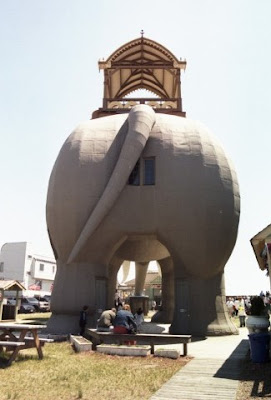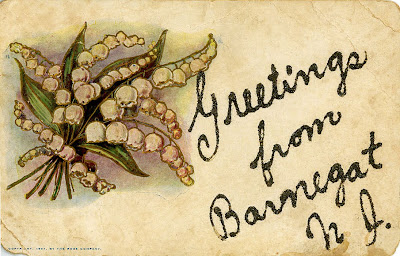
How to add a posting below . . .
Sunday, August 30, 2009
Photo ID Help Needed

Saturday, August 29, 2009
Principal Edward Petitt - Lost and Found
Pete,
Your blogs are great. They put life into the past of New Gretna for me. When I graduated from Pleasantville H.S. in the 60's, I had a summer job with W.R. Fisher and Son delivering frozen food to restaurants in South Jersey. I worked with "Teddy" Petit, who, was later a Principal in New Gretna. Any information or memories of him in your stash?
Thanks for the education and entertainment.
John Allen




Wednesday, August 26, 2009
The New Gretna PTA - 1960's Style






Sunday, August 23, 2009
Lucy the Elephant and the New York Syndrome

An ariel view shows Lucy at the corner of Atlantic and South Decatur avenues in Margate. For my history buddy, John Yates, the GPS coordinates are N39.3206/E-74.5117. (Map downloaded from Bing Maps.)

Lucy as she looks today, towering over an adjacent house on the Margate beachfront. (Photo by Bob Jagendorf downloaded from Flicker.com.)
Lucy is the world's largest elephant, and the only one in America designated as a National Historic Landmark. She was built in 1881 by James V. Lafferty, a Philadelphia real estate developer with a knack for promotion. Lafferty hoped that Lucy would draw people from bustling Atlantic City to buy property from him in Margate which, at the time, was in the middle of nowhere. She was so unique that the United States Patent Office gave Lafferty a patent giving him the exclusive right to make, use or sell animal-shaped buildings for seventeen years.
Lucy was originally named "Elephant Bazaar" until 1900, when she was rechristened Lucy. She was, and still is, an imposing sight, standing six stories tall, weighing 90 tons, covered with 12,000 square feet of sheet tin, and containing nearly one million pieces of wood. Lucy's body is 38 feet long and 80 feet in circumference; Her head, 16 feet long and 48 feet in circumference, sits atop a six feet long neck is that is 48 feet in circumference. Her body stands on 22 feet long legs that are10 feet in diameter with ears that are 17 feet long and 10 feet wide, each weighing 2,000 pounds. She has 22 feet long tusks at one end and a 26 feet long tail on the other end. Her glass, 18 inch round window eyes gaze out toward the Atlantic Ocean, and she is visible to the naked eye up to eight miles.
Lucy showed her versitility over the years, serving as Lafferty's real estate office and then becoming a restaurant, business office, cottage, and tavern which was closed down during prohibition.

A turn of the century postcard shows Lucy during her glory days. (Postcard downloaded from Google Images.)
Lafferty constructed two other elephant-shaped buildings after Lucy. The Elephantine Colossus, also known as the Elephant Hotel, was built at the Coney Island Amusement Park in Brooklyn, New York. The mamouth (Pardon the pun) structure dwarfed Lucy. It stood 12 stories (122 feet) tall, with legs 60 feet in circumference and housed a cigar store in one leg and a diorama display in another. Hotel rooms were located within the elephant's body, and an observation area at the top presented a panoramic view of the nearby ocean. It was destroyed by fire in 1896.

The Elephant Colossus at Coney Island. (Photo downloaded from Google Images.)
Lafferty's third elephant was was built in Cape May, New Jersey in 1884. Officially named the Light of Asia, it was dubbed Old Dumbo by locals, It was torn down before the turn of the century, giving Lucy the honor of being the sole surviving elephant building.

Artist's rendering of the Light of Asia at Cape May, New Jersey. It could pass as Lucy's twin sister. (Photo downloaded from Google Images.)
Lucy nearly didn't survive. Over the years her owners did little or no maintainance, and she became long in the tooth. By the late 1960's, she was an abandoned wreck on the verge of collapse.

Lucy fell into disrepair and was on the verge of callapse in the late 1960's. A "For Sale" sign hangs on her left front leg. (Photo by Yahonza downloaded from Flicker.com.)
Edwin T. Carpenter and a group of Margate citizens formed the Margate Civic Association, in 1969, to save and restore Lucy to her former grandeur. The group eventually became the Save Lucy Committee which, happily, was able to raise funds and move (2 blocks south) and restore Lucy in 1970. She was honored by the designation as a National Historic Landmark in 1976.
Today, for a small admission fee, you can tour Lucy's innards, entering via a spiral staircase in one of her hind legs.

Lucy's entrance door. (Photo downloaded from Google Images.)
Once inside, you may view a video and some photos of Lucy's facinating history. The tour finishes with a stop in the open-air "howdah" atop Lucy's back. From here you can get a breathtaking view of the Margate beachfront and the Atlantic Ocean.

Lucy looking toward the Atlantic Ocean. Bet you never thought you'd get mooned by an elephant. Now there's a window I'd be a little uncomfortable looking out of. (Photo downloaded from Google Images.)
You can take a video tour of Lucy, if you have high speed internet service, by clicking on the PLAY ARROW (>) below:
Following are a few old postcard views of Lucy that I downloaded from Google Images and thought you might enjoy.

A thirsty Lucy takes a drink.

How does one get room service on an elephant?
Thursday, August 20, 2009
"Greetings From" plus "Who is Katie Gerber?"










.jpg)
.jpg)

Katie Gerber (Photo courtesy of Paul Steinhauer.)

Circa 1910 - Photograph Taken in Front of the Grist MillStanding (L to T): Rev. Martha Jervis, Jules Gerber and his wife, Amos "Boney" Ford, and Ada ColemanSeated: Pauline Gerber and Mag Love.Herbert Adams is holding his brother, Percy, and their mother, Mary, is next to them.Percy was still living in Batsto as late as 1976.(Photo courtesy of Budd Wilson.)


Monday, August 17, 2009
More Oak Island Photos

This section from the 1858 Kuhn-Janney Map of Burlington County shows Oak Island with two houses, both belonging to a D. Mathis. It's likely that they refer to Daniel Mathis Jr. who occupied the island at that date. The French house along the Bass River was the second house built by the Great John Mathis in the area that is the Viking Boat works today. In 1858, it would have belonged to Thomas French, the oldest son of Francis French who bought the property from the Mathis family. The upper left portion of the map is the intersection of the present day Rt. 9 and Maple Avenues. Notice the Bass River Hotel on the South-East corner. The North-West corner is vacant as the New Gretna House has yet to be built.
DANIEL MATHIS’ ISLAND FARM
In the year 1713, John Mathis, William Birdsall and Moses Forman, all of whom then resided on Long Island, purchased of Daniel Leeds, of Springfield, 250 acres ,of land, in which was included this island, which at that time was called Biddle’s Island. Soon after this joint purchase, Birdsall and Forman sold their shares to John Mathis, thus constituting him the sole proprietor of the island. In the year 1716 John Mathis married and settled on this island, which he soon made into a farm. He made extensive banks around the island in order to defend it against the encroachments of the tide, and also built causeways, bridges and other conveniences. This island is noted for it’s valuable fisheries and its extensive salt marshes. After Job Mathis married, his father, John Mathis, deeded him this island farm; and after Job Mathis’ death, the farm came into the possession of his Son Daniel, who spent a long life there, and bequeathed the farm to his sons, Micajah Smith Mathis and Daniel Mathis. Daniel bought his brother’s share of the farm, thus constituting himself the sole proprietor. John Mathis built a bridge across the creek, between the island and the Francis French farm, and thus had a convenient communication between his two farms. The ownership of this island has been in the Mathis name ever since John Mathis purchased it — one hundred and fifty-five years ago.

Oak Island is the patch of trees seen on the right of this photo taken from the Job's Creek bridge on Route 9. (July 22, 2004 photo by Pete Stemmer.)



